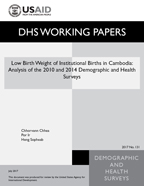- PUBLICATIONS
- JOURNAL ARTICLES
- ACCESS PUBLICATIONS
Publications Summary
- Document Type
- Working Papers
- Country(s)
- Cambodia
- Language
- English
- Recommended Citation
- Chhea Chhorvann, Por Ir, and Heng Sopheab. 2017. Low Birth Weight of Institutional Births in Cambodia: Analysis of the 2010 and 2014 Demographic and Health Surveys. DHS Working Paper No. 131. Rockville, Maryland, USA: ICF.
- Download Citation
- RIS format / Text format / Endnote format
- Publication Date
- July 2017
- Publication ID
- WP131
Download
 Low Birth Weight of Institutional Births in Cambodia: Analysis of the 2010 and 2014 Demographic and Health Surveys (PDF, 669K)
Low Birth Weight of Institutional Births in Cambodia: Analysis of the 2010 and 2014 Demographic and Health Surveys (PDF, 669K)
